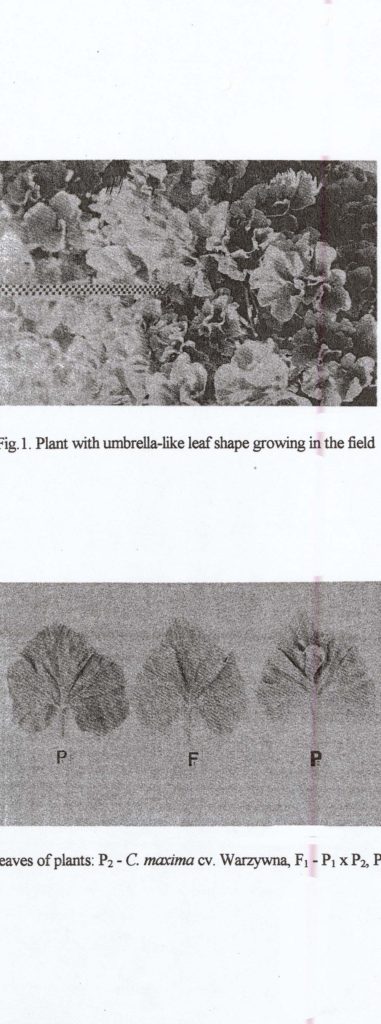Cucurbit Genetics Cooperative Report 22:50-52 (article 18) 1999
M. Rakoczy-Trojanowska and S. Malepszy
Department of Plant Genetics, Breeding and Biotechnology, Warsaw Agricultural University, Nowoursynowska 166, 02-787 Warszawa, Poland
Introduction
distant crosses in plants can be a tool for obtaining new forms for breeding and genetic investigations. Hybrids between squash (Cucurbita maxima Duch.) and pumpkin (C. pepo L.) were obtained in our Department over ten years ago (4). In the self-fertile BC2 /F2 progeny numerous variants have been selected (6). One of them was a new leaf shape, similar to the partially opened umbrella. this work presents the results of a genetic analysis of this trait.
Methods
Interspecific hybrids between Cucurbita maxima Duch., cv. Warzyna and C. pepo L., inbred line C2/3/9 (both components bred in our Department) were produced using the embryo rescue method, as described previously (4). They were self-incompatible and partially male-sterile, so, for obtaining the next generation, backcrosses with both parent were applied. Most of the BC1 plants (obtained by means of embryo rescue) were used as maternal forms, because of their self-incompatibility and complete or partial male-sterility (5). Several male- and self- fertile plants were found in the BC2 generation and it was possible to execute self-pollinations. In the BC2/F2 generation the selection of forms for further works has been started.
Results
Recovery of variants with umbrella-like leaf shape. In the BC2/F2 generation (derived from backcrosses with C. maxima) several plants were found with extensive chlorotic sectors on the leaves but still with very efficient photosynthesis. they were stabilized and in the subsequent third selected generation, three plants with normal green leaves but of unusual shape were segregated. Such a type of leaf shape has not hitherto been described in the literature, either for Cucurbita (2, 7) or Cucumis (3, 8). It was similar to a partially open umbrella (Fig. 1). Umbrella leaf has been described in cucumber, but is a completely different phenotype: “leaf margins turn down at low relative humidity making leaves look cupped” (1).
The plants with an umbrella-like leaf shape (uml) were self-pollinated and then sexually propagated and stabilized over three years. One of them segregated into plants with the regular leaf shape, plants with umbrella-like leaves of normal size and plants with umbrella-like, dwarf leaves (investigations on this phenotype are in progress), while the remaining plants turned out to be stable in theuml character.
Genetic analysis of umbrella-like leaf shape. The non-segregating progeny of the plant designated as P11.5.5 was used for genetic analysis (Table 1). All F1 plants showed intermediate leaf shape (Fig. 2). Segregation observed in all progenies indicate monogenic inheritance, of an incompletely recessive character and not influenced by cytoplasmic factors (Table 1). So, this trait does not results from a new complementary interaction of genes of both distant parents, but rather is caused by mutation.
We propose to designate the gene controlling this trait as uml.
Table 1. Genetic analysis of umbrella-like leaf shape derived from hybrids C. maxima x C. pepo.
| Cross | No. of plants | No. of plants with umbrella-like leaf shape | No. of plants with intermediate leaf shape | No. of plants with normal leaf shape | X2 | |||
| observed | expected | observed | expected | observed | expected | |||
| F1 (uml x W) | 10 | 0 | 0 | 0 | 10 | 0 | 0 | 0.00 |
| F1 (W x uml) | 10 | 0 | 0 | 10 | 10 | 0 | 0 | 0.00 |
| F1 (uml x W) x uml | 30 | 14 | 15 | 16 | 15 | 0 | 0 | 0.13 |
| F1 (uml x W) x W | 30 | 0 | 0 | 14 | 15 | 16 | 15 | 0.13 |
| F1 (W x uml) x uml | 30 | 14 | 15 | 16 | 15 | 0 | 0 | 0.13 |
| F1 (W x uml) x W | 30 | 0 | 0 | 16 | 15 | 14 | 15 | 0.13 |
| F1 (uml x W) self | 90 | 25 | 22.5 | 42 | 45 | 23 | 22.5 | 0.49 |
| F1 (W x uml) self | 90 | 19 | 22.5 | 50 | 45 | 21 | 22.5 | 1.20 |
W – C. maxima cv. Warzyna.
uml – forms with umbrella-like shape of leaves.
Literature Cited
- den Nijs, A.P.M. and O.M.B. de Ponti. 1983. Umbrella leaf: a gene for sensitivity to low humidity in cucumber. cucurbit Genet. Coop. Rpt. 6:24.
- Hutton, M.G. and R.W. Robinson. 1992. Gene list for Cucurbita spp. Cucurbit Genet. Coop. 15:102-110.
- Pitrat M. 1998. Gene list for melon. Cucurbit Genet. Coop. 21:69-81.
- Rakoczy-Trojanowska, M. and S, Malepszy. 1986. Obtaining of hybrids within the family Cucurbitaceae by in vitro culture of immature embryos. I. Characteristics of hybrids from Cucurbita maxima x Cucurbita pepo. Genet. Polon. 27(3-4):259-272.
- Rakoczy-Trojanow3ska, M. and S. Malepszy. 1989. Obtaining of hybrids withinthe family cucurbitaceae by in vitro culture of immature embryos. II. Characteristics of BC1 and F2 hybrids between Cucurbita maxima and C. pepo. genet. Polon 30(1-2):68-74.
- Rakoczy-Trojanowska, M. and S. Malepszy. 1992. Using Cucurbita maxima x C. pepo hybrids as breeding material. Fifth Eucarpia Cucurbitaceae Symp., July 27-31, Skierniewice, Warszawa, Poland: 47-50.
- Robinson, R.W. and M.G. Hutton. 1996. Update gene list for cucurbita spp. Cucurbit Genet. Coop. 19:91-92.
- Wehner, T.C. and J.E. Staub. 1997. Gene list for cucumber. Cucurbit Genet. Coop. 20:66-88.
